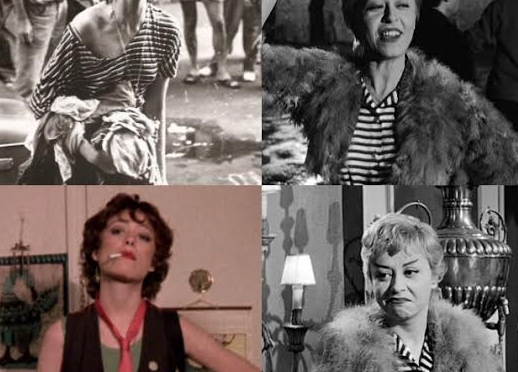Though Susan Seidelman’s most famous film is arguably Desperately Seeking Susan, her true pièce de résistance is, in fact, her debut, Smithereens. Filmed on and off in 1980 and 1981 (an injury incurred by Susan Berman after she fell off a fire escape during filming forced the crew to stop production while she healed), the movie, ultimately released in 1982, was made at a time when New York was at its most creatively free–Seidelman didn’t even know she needed permits to film in various locations, a testament to how cavalier the city once was with regard to “policy.”
But even more than Smithereens being about a specific moment in New York time, it is about a girl named Wren (Berman) who continues to get knocked down by life thanks, in large part, due to her transient existence. As Seidelman has confirmed, Federico Fellini’s Nights of Cabiria was a significant inspiration to the writing of the narrative and main character. Just as Cabiria (Giulietta Masina), a prostitute who has an endless string of bad luck relating to men, Wren seems to rely too heavily on the help of others, often giving them little in return.
Undeniably, the raw narcissism of Wren is almost a precursor to the chicness of selfishness now, the primary tasks of her night consisting of wheat-pasting walls with Xeroxed images of herself that say “Who is this?” And when she’s not promoting herself (though what she’s promoting, exactly, is never really clear to her or others), she’s looking for contacts, anyone who can aid in getting her to one of her primary goals, “eating tacos and signing autographs.” Often frequenting the Peppermint Lounge, Wren fixates on one punk singer in particular, Eric (Richard Hell, who would later cameo as Susan’s murdered boyfriend in Desperately Seeking Susan). Although she deviates from Cabiria in the respect of being hyper self-involved, the vulnerability of both women shines through in every frame, each wanting so badly to be wanted by someone–usually the very one who couldn’t care less about them.
As Wren pursues Eric with faux casual intensity, Cabiria, too, chases movie star Alberto Lazzari (Amedeo Nazzari) after his model-esque girlfriend dumps him. With no one else to turn to for sexual solace, in spite of the fact that Cabiria is remarkably lacking in glamor, he takes her back to his lavish home. Wearing her signature tattered fur coat (one that gets reinvented in pink form for Wren’s wardrobe in Smithereens), Cabiria looks more out of place than ever among these extravagant settings. Still, she believes she might fulfill her fantasy to sleep with a movie star, only to be shuffled into the bathroom like trash when Alberto’s girlfriend returns to his apartment. Equivalently, Wren experiences the same treatment after Eric’s girlfriend–who we later learn is his wife–(Kitty Summerall), gets in a fight with Eric outside of a bar, leaving Wren the opportunity to capitalize on it. Hours later, however, when Wren is back at his apartment, his girlfriend returns to reimpose her presence. Back on the move again, the constant motion–the walking–of Smithereens closely resembles Nights of Cabiria as well. After all, Cabiria’s profession is streetwalking.
The beginnings and conclusions of each film also bear similarities in starkness and shock value. In Smithereens, the camera hones in on a woman holding Patricia Field checkered sunglasses. A moment of tranquil calm washes over the screen as they dangle in the woman’s hand. Then, abruptly, Wren snatches them from her, running down the subway steps and into the abyss of the underground, so we’re given the sense of constant energy and ephemerality that punctuates not just her lifestyle, but all of New York. Likewise, our introduction to Cabiria is a jarring one, showing her current boyfriend pushing her into the river in order to steal her cash-stocked purse. Thus, from the outset of each film, we’re imbued with the tragic nature of Wren and Cabiria, one that they battle against tooth and nail.
Just as Wren does, Cabiria must always exist in a state of flux, never knowing who her next client will be, or where she’ll be staying for the night. The vagabond nature of both women colors the events that happen to them, and yet, it is as though neither one would have it any other way.
Though Cabiria and Wren have both been burned by lovers past, they decide to trust again, placing their faith in men who end up duping them for financial benefit. While Wren has one man who truly cares for her, Paul (Brad Rijn), a fresh off the boat from Montana portrait artist, Cabiria doesn’t ever quite finagle this form of pure love. Nonetheless, for as much as Wren is a punk bag lady, Cabiria is a punk prostitute wanderer, who, for as often as experience tells her otherwise, can’t seem to ever fully lose her faith in humanity.
To cinch Smithereens‘ inspired by vibe when it comes to Nights of Cabiria, the fate that ends up befalling Wren is a pitiful one. And, once again, she’s left with nothing to do but walk, where to, she doesn’t know. But as a stranger driving next to her on the George Washington Bridge remarks in order to cajole her into his car: “Come on, you got somethin’ better to do with your time?” In the long run, we’re all just passing the moments until we get to something better. For Wren and Cabiria, they’ll walk anywhere and endure any doleful plight to get to that point of betterness. Not bitterness.






















